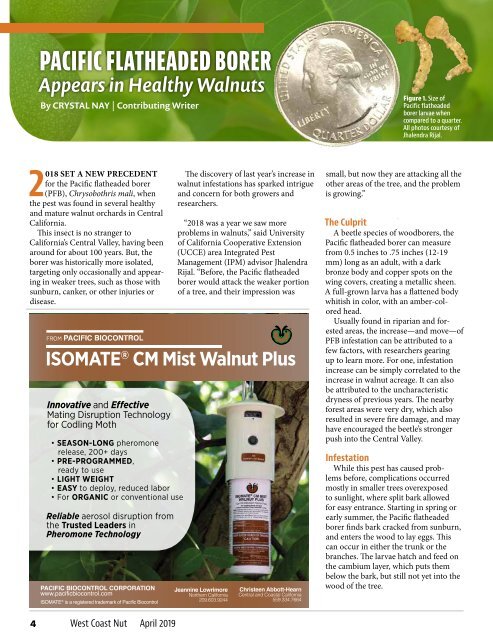WCN April 2019
Create successful ePaper yourself
Turn your PDF publications into a flip-book with our unique Google optimized e-Paper software.
PACIFIC FLATHEADED BORER<br />
Appears in Healthy Walnuts<br />
By CRYSTAL NAY | Contributing Writer<br />
Figure 1. Size of<br />
Pacific flatheaded<br />
borer larvae when<br />
compared to a quarter.<br />
All photos courtesy of<br />
Jhalendra Rijal.<br />
2018 SET A NEW PRECEDENT<br />
for the Pacific flatheaded borer<br />
(PFB), Chrysobothris mali, when<br />
the pest was found in several healthy<br />
and mature walnut orchards in Central<br />
California.<br />
This insect is no stranger to<br />
California’s Central Valley, having been<br />
around for about 100 years. But, the<br />
borer was historically more isolated,<br />
targeting only occasionally and appearing<br />
in weaker trees, such as those with<br />
sunburn, canker, or other injuries or<br />
disease.<br />
The discovery of last year’s increase in<br />
walnut infestations has sparked intrigue<br />
and concern for both growers and<br />
researchers.<br />
“2018 was a year we saw more<br />
problems in walnuts,” said University<br />
of California Cooperative Extension<br />
(UCCE) area Integrated Pest<br />
Management (IPM) advisor Jhalendra<br />
Rijal. “Before, the Pacific flatheaded<br />
borer would attack the weaker portion<br />
of a tree, and their impression was<br />
ISOMATE ® CM Mist Walnut Plus<br />
Innovative and Effective<br />
Mating Disruption Technology<br />
for Codling Moth<br />
• SEASON-LONG pheromone<br />
release, 200+ days<br />
• PRE-PROGRAMMED,<br />
ready to use<br />
• LIGHT WEIGHT<br />
• EASY to deploy, reduced labor<br />
• For ORGANIC or conventional use<br />
Reliable aerosol disruption from<br />
the Trusted Leaders in<br />
Pheromone Technology<br />
PACIFIC BIOCONTROL CORPORATION<br />
www.pacificbiocontrol.com<br />
ISOMATE ® is a registered trademark of Pacific Biocontrol<br />
Jeannine Lowrimore<br />
Northern California<br />
209.603.9244<br />
Christeen Abbott-Hearn<br />
Central and Coastal California<br />
559.334.7664<br />
small, but now they are attacking all the<br />
other areas of the tree, and the problem<br />
is growing.”<br />
The Culprit<br />
A beetle species of woodborers, the<br />
Pacific flatheaded borer can measure<br />
from 0.5 inches to .75 inches (12-19<br />
mm) long as an adult, with a dark<br />
bronze body and copper spots on the<br />
wing covers, creating a metallic sheen.<br />
A full-grown larva has a flattened body<br />
whitish in color, with an amber-colored<br />
head.<br />
Usually found in riparian and forested<br />
areas, the increase—and move—of<br />
PFB infestation can be attributed to a<br />
few factors, with researchers gearing<br />
up to learn more. For one, infestation<br />
increase can be simply correlated to the<br />
increase in walnut acreage. It can also<br />
be attributed to the uncharacteristic<br />
dryness of previous years. The nearby<br />
forest areas were very dry, which also<br />
resulted in severe fire damage, and may<br />
have encouraged the beetle’s stronger<br />
push into the Central Valley.<br />
Infestation<br />
While this pest has caused problems<br />
before, complications occurred<br />
mostly in smaller trees overexposed<br />
to sunlight, where split bark allowed<br />
for easy entrance. Starting in spring or<br />
early summer, the Pacific flatheaded<br />
borer finds bark cracked from sunburn,<br />
and enters the wood to lay eggs. This<br />
can occur in either the trunk or the<br />
branches. The larvae hatch and feed on<br />
the cambium layer, which puts them<br />
below the bark, but still not yet into the<br />
wood of the tree.<br />
4<br />
West Coast Nut <strong>April</strong> <strong>2019</strong>


















